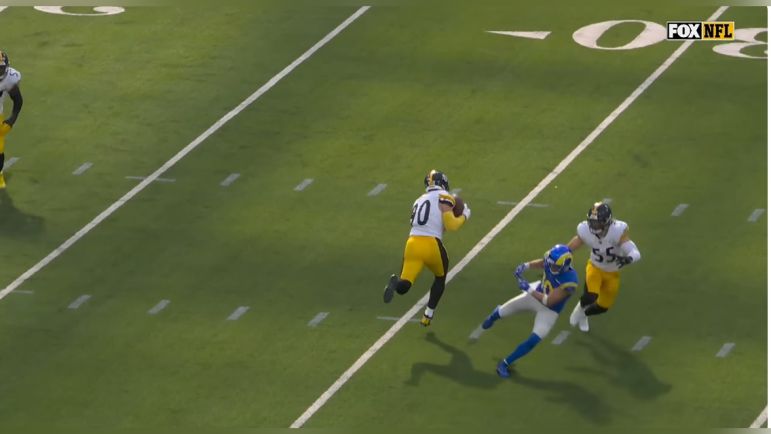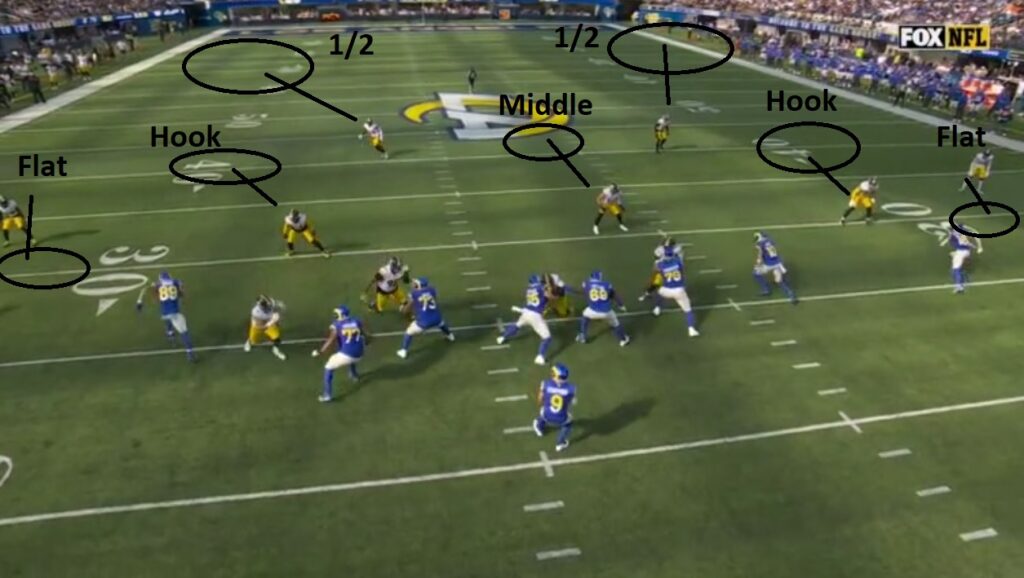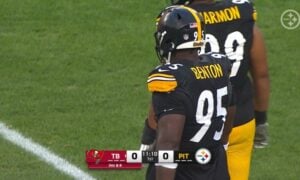It takes a lot for me to be amazed by T.J. Watt. The dude is on track to become a first ballot Hall of Famer. He’s beaten ̶d̶o̶u̶b̶l̶e̶ triple teams, jumped into the air to pick off passes, taken over games early and late and been an all-around wrecking ball.
But his third quarter interception against the Los Angeles Rams made even me jump out of my seat. Maybe that’s because we don’t see Watt truly drop into coverage often. He gets paid to rush the quarterback and oh boy does he do it well. As a rookie, he dropped into coverage 37 percent of the time. If Watt did that today, someone would be fired. In recent years, that number has hovered between five and 10 percent. When Watt, or any of the Steelers outside linebackers drop, it’s almost always for one of three reasons.
1. Against empty sets where the offense has spread the field and the defense needs to drop additional guys into coverage to compensate
2. On the backside of blitzes. If the Steelers are overloading one side or even sending “safe” pressure with a nickel blitz, often the backside outside linebacker away from the blitz will drop into coverage to be an additional man in coverage and with the hopes the quarterback will throw “hot” right into him.
3. Against Twin WR sets. Because Pittsburgh rarely travels its cornerbacks, when teams are in 12/21 personnel with two receivers to one side, the Steelers’ EDGE rusher to that side often walks out to help cover.
Other than that, they’re rushing. On Watt’s interception, the Rams were working out of empty. Here’s the play call and the coverage.
Rams Play call: Hoss Y Juke
Steelers Play call: Cover 2
Let’s walk through each.
Hoss Y Juke
If you watched New England Patriots TE Rob Gronkowski throughout basically his entire career, you probably saw Hoss Y Juke. Essentially, it’s two bubble/stop routes on the outside with two seam routes and an option route over the middle by the “Y,” which for the Patriots meant Gronkowski and for the Rams Sunday, Cooper Kupp.
It’s a play they’ve used with Kupp since he returned. On 1st and 10 in Week Five against the Philadelphia Eagles, they used Hoss Y Juke out of empty early in the game. QB Mathew Stafford hit Kupp over the middle for a solid completion.
That’s what the Rams went back to coming out of the first half.
Cover 2
Pittsburgh ran Cover 2 against it. A two-deep shell where each safety is responsible for his half of the field. The cornerbacks have the flats, and the linebackers have the underneath zones (there’s also Tampa 2 where the MIKE runs with anything down the seam to the strength of the formation). Here, Watt is in a hook zone, essentially taking away any curl and being able to expand to the flat to rally for any throw there, though that is the cornerback’s responsibility.
Here’s the coverage as drawn up by my sick Microsoft Paint skills. That’s Watt on the right side with hook responsibility.
On the snap, he allows the No. 2 receiver to run vertically down the seam because he’s not matching the route. It’s true spot-drop zone coverage. Get to your depth, vision on the quarterback, break on the ball. But Watt has an unbelievable read and drives from his hook zone to the middle of the field, an area he’s not responsible to cover, and steps in front of Stafford’s pass for Kupp and picks it off. He returns it the other way, nearly for a touchdown, before being tackled at the Rams’ 7-yard line.
Watch the play but again, this isn’t Watt’s zone. He just goes and makes the play. And watch Stafford. He doesn’t even react, doesn’t even realize Watt has the ball for seconds after the interception. He thinks Kupp had to have caught it because he almost always does. Until Watt’s on the field.
After the game, Rams’ head coach Sean McVay added some detail to what went wrong. His comments. per the Rams’ site that sent out this transcription.
“Bottom line is that we had hitches on the outside for a little option route from the three spot and seams at the two spot. We obviously thought it was going to be a single high. Steelers CB Levi Wallace rolled up as a cloud and got WR Cooper (Kupp) working an option on the MIKE and you don’t feel that overlap from the hook player when (Steelers LB T.J.) Watt ended up dropping out of there and that’s what led to the turnover.”
McVay is referring to Kupp on the option route from the “three spot” (the No. 3 receiver, the furthermost inside one to the right) and seams at the “two spot (the dual No. 2 receivers to each side). He’s referring to Wallace as a “cloud’ as the flat corner and referring to Watt as the hook player.
As you can see in the above clip against the Eagles, the Rams like running this versus single high. Really, against either Cover 1 where Kupp can win with his route running or Cover 3 when there’s only four underneath defenders instead of five like the Steelers used in Cover 2. More defenders mean tighter window throws on that option route.
Still, for Watt to recognize the route, no doubt from his film study, and be able to react in that instance and finish is the play is just off the charts. I know we praise him all the time and it’s nothing Steelers fans don’t know, Watt is freakin’ incredible, but you see it in all aspects. It’s not just winning the edge and rushing the passer. It’s batting balls down at the line, it’s playing the run hard, it’s dropping into coverage and making a play like an All-Star corner.
There is a healthy debate to be had about the likes of Watt versus Myles Garrett. But I’ll tell you what: Garrett doesn’t make these plays. Watt does. And it’s a reminder that Watt might not be the freakshow athlete Garrett is but he’s a remarkable athlete of his own who tested extremely well coming out of Wisconsin (a 9.92 RAS coming out).
When the Steelers need a big play from their defense, which is just about every game, Watt provides it. Sunday, it didn’t come with a sack — the Rams had a good game plan to take him away to the point the Steelers were occasionally flipping Watt’s side to rush from (something they basically never do) — but he still found a way to significantly impact the game. The great ones always do.









